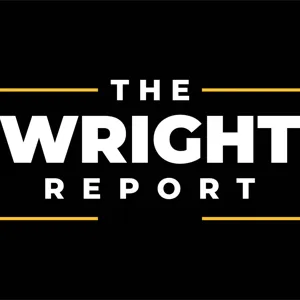Podcast Summary
Decarbonizing the economy: Reaching net zero emissions: The world aims to reach net zero emissions by 2050 or sooner to prevent climate change, with the US targeting this goal as well. Decarbonization requires industry changes, new technologies, and policies, with the Inflation Reduction Act being a step towards this goal.
Decarbonizing the economy is a central task of our era to prevent the worst impacts of climate change. Net zero emissions, or the point where human greenhouse gas emissions are balanced by removals, is the goal. The world needs to reach net zero emissions globally as rapidly as possible, ideally by 2050 for a 1.5°C limit or sooner for a 2°C limit. The United States, given its wealth, technological capability, and historical contributions, should aim for net zero emissions by 2050 at the latest. Decarbonization involves changing industries, building new technologies, and implementing policies. The Inflation Reduction Act, recently passed in the US, is a step towards this goal but does not solve all the challenges. Experts like Jesse Jenkins, an energy and climate expert at Princeton University, can provide valuable insights into the path to decarbonization and the role of policies like the Inflation Reduction Act.
Expanding the role of clean electricity for a net zero future: To reach net zero emissions, we need to expand the supply of clean electricity and reduce the demand for fossil fuels through carbon-free alternatives like hydrogen and negative emissions technologies.
Electricity is a crucial linchpin in achieving net zero emissions due to it being a carbon-free energy carrier. Unlike liquid and gaseous hydrocarbons, which emit CO2 when consumed, electricity itself does not release CO2 when used. Currently, about 40% of electricity is already produced from carbon-free sources. To decarbonize further, we need to expand the supply of clean electricity and reduce the demand for liquid and gaseous fuels. This can be achieved through growing the role of electricity and other carbon-free energy carriers like hydrogen, producing carbon-free liquid fuels from CO2 and hydrogen, and implementing negative emissions technologies like carbon capture and storage. The challenge lies in finding cost-effective and mature solutions for these alternatives, particularly for sectors that are difficult to decarbonize, such as aviation. Overall, the expansion of clean electricity production is essential for a net zero future.
Building Two New Power Grids by 2050: The US must transform energy production, transportation, and consumption at a massive scale to meet net-zero emissions by 2050, requiring significant investment and ensuring equitable process.
The United States needs to build nearly two new power grids by 2050 to meet its net-zero emissions goal. This involves eliminating fossil fuels from the grid and increasing overall electricity supply to power various sectors. The challenge is massive, requiring the transformation of energy production, transportation, and consumption at a scale not seen since the nation-building era. This transition will require significant investment in physical infrastructure and may impact people's lives, so it's crucial to ensure that the process is equitable and does not repeat past harms. The good news is that this transformation is affordable and offers public health benefits, making it a worthwhile endeavor for the future.
Building renewable energy infrastructure on a national scale: Rapidly decreasing costs of solar, wind, and batteries make large-scale renewable energy infrastructure more achievable than ever before, despite the significant construction challenges.
The transition to renewable energy on a national scale requires building vast amounts of infrastructure, specifically solar and wind farms, which will have significant visual impacts. The most cost-effective scenario for achieving net-zero emissions spans an area equivalent to several states, and installing the necessary utility-scale solar and wind capacity each year would represent a substantial construction challenge. However, the good news is that solar, wind, and battery costs have been decreasing rapidly, making these decarbonization pathways more achievable than ever before. The challenge is to keep breaking records in renewable energy installation year after year. While the scale of this endeavor is intimidating, the fact that it is even a viable option is almost miraculous. The US has already exceeded its 2020 record for renewable energy installation in 2021, and is on track to double that peak by the end of this year.
Cost reduction of renewable energy technologies unlocks decarbonization ambition: The Inflation Reduction Act accelerates decarbonization by offering subsidies and incentives for clean energy, building on cost reduction trends and driving innovation for next-gen technologies.
The rapid decline in the cost of renewable energy technologies, particularly solar PV and lithium-ion batteries, has been a game-changer in unlocking increased policy ambition and private sector commitments towards decarbonization. This cost reduction has made clean energy the economically viable option, transforming the power and transportation sectors. The Inflation Reduction Act further accelerates this trend by offering subsidies, tax credits, rebates, and financing to make clean energy the preferred choice for businesses and individuals. By subsidizing decarbonization instead of pricing carbon, the U.S. is following the successful model of countries like Germany, Spain, and China, which subsidized the deployment of these technologies when they were expensive and drove innovation and cost declines. This bill aims to kickstart the same process for the next generation of technologies, enabling the U.S. to continue its progress towards a net-zero emissions future.
Making energy cheaper and cleaner for all Americans: The Inflation Reduction Act taxes corporations and tax cheats to fund clean energy subsidies, but addressing other challenges like permitting, land availability, supply chain issues, and capacity planning is also necessary for accelerating the energy transition.
The Inflation Reduction Act aims to make energy cheaper and cleaner for all Americans by taxing corporations and tax cheats, and using the collected revenue to subsidize clean energy production. However, it's important to note that while money is a necessary condition for accelerating the energy transition, there are other challenges such as permitting, land availability, supply chain issues, and capacity planning that need to be addressed. The bill does not provide a central coordinator or vast new powers to the federal government to decide where things go. Nevertheless, the alignment of financial incentives towards clean energy choices is crucial for making progress at the required pace.
Significant financial incentives for clean energy in the Inflation Reduction Act: The Inflation Reduction Act offers billions in profits for companies and savings for consumers, unlocking economic development and addressing challenges in clean energy expansion, transmission, workforce growth, and local economy transitions. However, political resistance may limit its impact in some states.
The Inflation Reduction Act represents a significant shift in financial incentives for clean energy, offering billions of dollars in profits for companies and savings for regulators, rate payers, and energy consumers. This change could help unlock economic development and solve some of the challenges related to clean energy expansion, transmission, workforce growth, and local economy transitions. However, there's a risk of politicization, as some states may resist participating due to partisan reasons. Unlike Medicaid expansion, which is state-adminaged, the Inflation Reduction Act is primarily implemented through the federal tax code, limiting the role of governors in its implementation. The bill also includes industrial policies designed to bring tangible economic benefits to diverse communities across the country, making the clean energy economy a more direct concern for a broader range of Americans.
Revitalizing communities and creating jobs in clean energy sector: The Inflation Reduction Act focuses on reducing emissions, making clean energy cheaper, revitalizing communities, and creating jobs in the clean energy sector to ensure a sustainable and politically viable clean energy transition
The Inflation Reduction Act is not just about reducing emissions and making clean energy cheaper, but also about revitalizing communities and creating good jobs in the clean energy sector. This approach is crucial for sustaining the clean energy transition and transforming the politics of the transition. While some argue that adding standards may make the task more challenging, it is essential to build a workforce and expand the political stake of communities in the transition. The bill aims to unlock feedback loops and disrupt current interests that oppose clean energy transitions, ultimately driving the transition towards net zero emissions.
Impact of Inflation Reduction Act on Clean Energy Politics: The Inflation Reduction Act's focus on domestic supply chains could initially slow down the clean energy transition in some industries, but long-term incentives for battery production could lead to substantial investment and sustain political support for the net-zero emissions transition.
The Inflation Reduction Act of 2022 will have a significant impact on the politics of clean energy in America beyond its direct emissions reductions. While the act includes provisions for apprenticeship programs and good wages, its emphasis on domestic supply chains could slow down the clean energy transition in some cases, particularly in the electric vehicle and battery industries. However, these concerns may be overwrought in the near term as demand for electric vehicles continues to outstrip supply. In the long term, the act's incentives for investing in North American battery production could lead to substantial investment in the sector and help sustain the economic and political coalition needed for the transition to net-zero emissions. The act also acknowledges the need for a diverse energy mix beyond wind and solar, and it's important to explore other promising energy sources to build out the rest of the team.
Balancing Renewable Energy with Different Energy Sources: Renewable resources, fast burst resources, and firm resources are essential for a balanced energy system. Renewables save fuel costs and reduce emissions, fast burst resources provide short-term flexibility, and firm resources ensure consistent power.
Building an effective energy system requires a balance of different energy sources and technologies. The first role is filled by renewable resources like wind and solar, which can save fuel costs and reduce emissions by displacing more dependable resources when available. The second role is filled by fast burst or balancing resources like batteries and demand response programs, which provide short-term flexibility to align supply and demand. The third role is filled by firm resources or clean firm resources, which provide consistent power for long periods of time and replace dirty options. Nuclear power currently plays a significant role in this third category, providing about half of our clean electricity, but its future role is uncertain. Preserving the operation of existing nuclear plants is critical to accelerating emissions reductions, but new clean firm options like advanced geothermal and new nuclear power plants will also be needed to ensure a reliable and clean energy future.
Challenges in building large-scale nuclear infrastructure in the US: Despite potential benefits, lack of new US nuclear plants since 1970s due to complex infrastructure project challenges. Shift to smaller, modular reactors may revive industry.
The lack of new civilian nuclear plants in the US since the 1970s, despite the potential benefits of nuclear energy as a clean, stable source, can be attributed to the challenges of building large-scale infrastructure projects in the country. Regulatory conditions have kept existing nuclear plants safe, but the US has lost the ability to construct complex civil works projects efficiently. A shift towards smaller, modular reactors may be a more feasible solution for reviving the nuclear industry in the west, as these reactors require smaller investments and can be built more frequently to develop economies of scale and a skilled workforce.
Carbon capture: A crucial part of decarbonization despite challenges: Carbon capture technologies are essential for reducing emissions from heavy industries, but their economic viability is a challenge. The Inflation Reduction Act aims to help with tax credits, while critics argue against fossil fuel companies' use of carbon capture to continue production.
Carbon capture technologies are a crucial part of many decarbonization pathways, despite being controversial. Carbon capture involves taking CO2 from combustion or industrial processes, storing it safely, or using it in industrial processes. The infrastructure required for CO2 transport and storage is massive, equivalent to 1.3 to 2.4 times current US oil production. While we have the physical capacity to build this infrastructure due to our existing oil and gas infrastructure, the challenge lies in making CO2 capture economically viable. The Inflation Reduction Act aims to help by increasing tax credits for capturing and storing CO2. Critics argue that fossil fuel companies are the primary cause of climate change and that carbon capture allows them to continue producing fossil fuels in a cleaner way. However, proponents argue that carbon capture is necessary to eliminate emissions from heavily emitting industries like cement and steel production. While there are technical challenges, the potential economic benefits and the need to address emissions make carbon capture an important part of the decarbonization solution.
Carbon capture: Progress or perpetuation?: Carbon capture is a complex issue, with potential benefits for decarbonization and environmental justice, but also concerns about perpetuating fossil fuel use. The decision to use it depends on various factors.
The debate around carbon capture and its role in reducing greenhouse gas emissions is complex and multifaceted. On one hand, there are valid concerns about perpetuating fossil fuel use and the associated environmental justice issues. On the other hand, some argue that using carbon capture could help make faster progress towards decarbonization and improve environmental justice outcomes in certain cases. Ultimately, the decision to use carbon capture or not depends on various factors, including political considerations and the feasibility of rapidly expanding renewable energy sources. It's important to acknowledge that every energy technology has its own impacts and challenges, and a diverse energy mix is necessary to address the complex realities of energy production and consumption.
A diverse energy mix is crucial for the US energy system: Investing in a range of energy technologies and supporting their development is important for a reliable, cost-effective, and low-carbon energy future in the US, with advanced hydrogen, geothermal, wind, solar, and nuclear among the key players.
A diverse energy mix is crucial for a complex energy system like the United States. Renewable energy sources, such as wind and solar, are essential, but they are not always reliable or cost-effective. Nuclear power and natural gas, among other resources, also have their place in the energy landscape. The challenge lies in building infrastructure that can effectively utilize various resources and address land use, economic, and transmission issues. Carbon capture technology is one such option, but its reliability and scalability are still uncertain. The success of wind and solar over the past decade serves as a reminder of the importance of investing in a range of technologies and supporting their development through research, demonstration, and deployment. The Inflation Reduction Act and Infrastructure Law aim to do just that, incentivizing the scaling up of various technologies, including carbon capture, nuclear, advanced geothermal, and hydrogen production. These investments could lead to significant emissions reductions in the future. Looking 15 years ahead, advanced hydrogen and geothermal are among the technologies that could become central to our energy future, alongside wind, solar, and other established resources.
Clean Energy Revolution: Geothermal, Nuclear, Carbon Capture, and Hydrogen: The US is leading the charge in the clean energy revolution with trials and scalings of advanced technologies like geothermal, nuclear, carbon capture, and hydrogen, driven by policies and the oil and gas sector's expertise.
We are on the brink of a clean energy revolution, with various advanced technologies such as geothermal energy, nuclear power, carbon capture, and clean hydrogen production set to be trialed and scaled up in the coming years. The US, in particular, is poised to make significant strides in this area, leveraging its experience in drilling and innovation from the oil and gas sector. The Inflation Reduction Act and other policies are expected to accelerate the transition to electric vehicles and electrify home heating industries, making them more affordable and accessible to consumers. Geothermal energy, with its modular nature and potential for innovation, is expected to see significant success. Nuclear power and carbon capture projects are also set to move forward, while clean hydrogen production offers a carbon-free alternative as a fuel or energy carrier. Overall, the next decade is expected to see an explosion of investment in clean energy technologies and infrastructure.
The Inflation Reduction Act makes EVs more affordable with up to $75,100 tax credit: The Inflation Reduction Act offers tax credits up to $75,100 for consumers buying electric vehicles, making them cheaper than gas-powered cars by mid-2020s. The Act also incentivizes businesses to adopt electric vehicles and install heat pumps for home heating, accelerating the transition to clean energy.
The Inflation Reduction Act aims to make electric vehicles (EVs) more affordable for consumers by offering up to a $75,100 tax credit. This credit, which can be claimed if automakers meet certain sourcing requirements, is expected to significantly reduce the upfront cost of EVs, making them cheaper than gas-powered vehicles by the mid-2020s. Additionally, the Act includes tax credits for businesses adopting electric vehicles, which could lead to widespread electrification in sectors like shipping, freight, and fleet vehicles. While there are concerns about the potential for corporate welfare, the tax credits are likely to be passed on to consumers as competition increases and more EV models become available. Another important aspect of the Act is the focus on heat pumps for home heating. Heat pumps represent a significant infrastructure upgrade, but they can help reduce greenhouse gas emissions and save money on energy bills in the long run. The Act includes incentives for installing heat pumps, making this upgrade more accessible for homeowners. Overall, the Inflation Reduction Act is expected to accelerate the transition to clean energy in various sectors, from transportation to home heating.
Heat pumps: Efficient and carbon-free solution for heating and cooling: Heat pumps provide up to 3x heat for every electricity unit, are carbon-free, and are encouraged by tax credits, but expanding transmission infrastructure is crucial to meet decarbonization goals.
Heat pumps are an efficient and carbon-free solution for heating and cooling our homes and water. They work by moving heat instead of generating it, making them much more energy-efficient than traditional heating methods like boilers. Heat pumps can provide up to three units of heat for every unit of electricity consumed. The Inflation Reduction Act aims to encourage heat pump adoption by offering tax credits for installation, but the credits may not cover a significant portion of the upfront cost. To meet our decarbonization goals, we need to significantly expand transmission infrastructure to transport the clean electricity generated by wind and solar power to where it's needed. This requires more than doubling the pace of transmission expansion seen over the last decade, which presents a significant challenge. Heat pumps and electric vehicles are key technologies in the decarbonization challenge as they don't involve burning fossil fuels and are more efficient in converting energy to useful services.
Expanding the Transmission Grid for Renewable Energy: The Inflation Reduction Act's permitting reform bill aims to accelerate the expansion of the transmission grid by streamlining the permitting process and addressing cost allocation issues, enabling the development of renewable energy sources and enhancing grid resilience.
Expanding the transmission grid to meet growing electricity demand, particularly for renewable energy sources like wind and solar, is crucial. However, the current pace of expansion at about 1% per year is not enough. Historically, during periods of high electricity demand growth, the grid expanded at a rate of 2% per year. To meet the demands of the future, including the increasing use of electric vehicles and heat pumps, we need to double the current pace. The permitting reform bill, which is part of the Inflation Reduction Act, aims to help accelerate this expansion by expanding the federal government's authority to site, plan, and allocate costs for interregional and interstate transmission lines. This would streamline the permitting process, which is currently a major challenge for building out transmission lines. The bill also addresses the issue of who pays for these lines, particularly those that span different grid regions. Expanding the grid is important for several reasons. First, it enables the development of renewable energy sources by addressing the challenges of siting and connecting these facilities to the grid. Second, it allows for the movement of power over long distances, enhancing grid resilience and unlocking competition and lower costs over wider regions. Overall, the expansion of the transmission grid is essential for meeting growing electricity demand and transitioning to a cleaner energy future.
Allocating transmission line costs using the beneficiary pays principle: The Inflation Reduction Act's proposal to use the beneficiary pays principle for interregional transmission lines could lead to more efficient infrastructure development and significant health benefits from reduced pollution.
The Inflation Reduction Act proposes using the beneficiary pays principle to allocate costs for interregional transmission lines, which would help resolve long-standing disputes and accelerate infrastructure projects. This policy change is crucial for efficient infrastructure development in the context of the ongoing energy transition. Moreover, decarbonizing America through the transition from fossil fuels to clean energy could lead to significant health benefits, including the avoidance of tens of thousands of premature deaths due to reduced fine particulate matter and other pollutants. This secondary benefit underscores the importance of expediting the clean energy transition, not only for climate change mitigation but also for public health.
Expanding clean energy infrastructure to reduce emissions and improve public health: Expanding clean energy infrastructure can save tens of thousands of lives by reducing air pollution and health impacts on vulnerable communities. Recommended books for policy interventions include 'Making Climate Policy Work', 'Sequencing to Ratchet Up Climate Policy Stringency', and 'How Solar Energy Became Cheap'.
The Inflation Reduction Act's potential to significantly reduce emissions and improve public health is closely linked to the expansion of clean energy infrastructure. This infrastructure will primarily benefit communities disproportionately affected by fossil fuel pollution. The more transmission lines and renewable energy sources we build, the lower the air pollution and health impacts on vulnerable communities, potentially saving tens of thousands of lives. Additionally, Professor Jesse Jenkins recommends three books for those interested in making strategic policy interventions to accelerate emissions reductions: "Making Climate Policy Work" by Danny Cullenward and David Victor, "Sequencing to Ratchet Up Climate Policy Stringency" by Michael Paley et al., and "How Solar Energy Became Cheap" by Gregory Nemet. These works explore the political economy of carbon pricing, the importance of policy sequencing, and the history of solar energy's cost decline, respectively.
The Impact and Importance of the Inflation Reduction Act: The Inflation Reduction Act is a significant climate legislation in the US, addressing carbon emissions, clean energy, healthcare, and taxes, with positive impacts on the economy and environment, and a major victory for climate advocates.
Learning from this episode of the Ezra Klein Show is the importance and impact of the Inflation Reduction Act, a key piece of climate legislation in the United States. Host Ezra Klein interviewed Jenkins and Leah Stokes in two separate conversations about the Act, with the second discussion delving deeper into its specific provisions. For those seeking a more detailed understanding of the legislation, Klein recommends checking out these conversations. Overall, the Inflation Reduction Act represents a significant step forward in addressing climate change and reducing carbon emissions, with provisions related to clean energy, healthcare, and taxes. The Act is expected to have a positive impact on the economy and the environment, and its passage marks a major victory for climate advocates. The Ezra Klein Show is produced by Andy Galvin and Rochekarma, with fact-checking by Michelle Harris, Mary Marge Locker, and Roland Hu, original music by Isaac Jones, mixing by Carol Saburo and Isaac Jones, audience strategy by Shannon Busta, and special thanks to Kristen Lin and Christina Samilewski.





